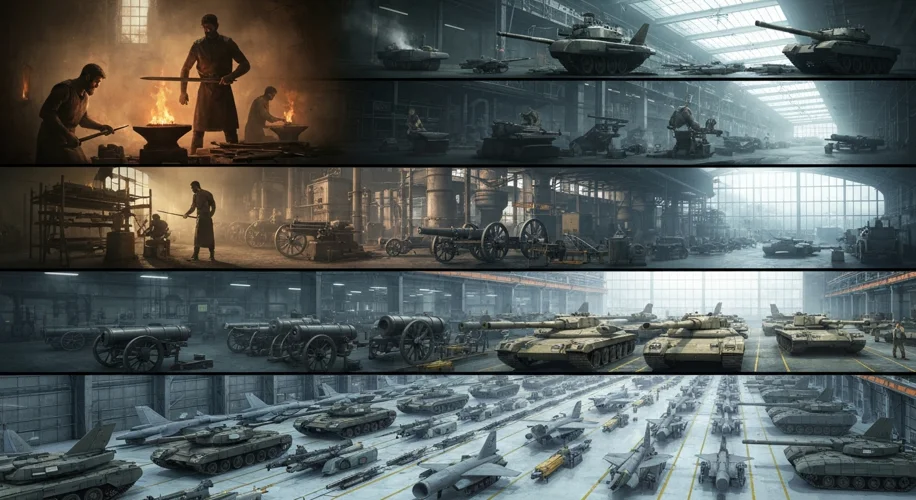The clang of hammer on steel, the hiss of steam, the crackle of gunpowder – these are the ancient symphonies of war, sounds that have echoed through human history. But the art of arming ourselves has evolved, morphing from blacksmiths to massive industrial complexes, and from simple swords to the sophisticated weaponry that defines modern conflict. This evolution is not just about technology; it’s about power, economics, and the intricate dance of global alliances. At the heart of this transformation lies the military-industrial complex, a concept made famous by President Eisenhower, and its intertwined relationship with organizations like NATO.
The story of arms manufacturing is as old as civilization itself. Early societies developed tools for hunting and defense, which quickly morphed into weapons of war. The Bronze Age saw a revolution in metallurgy, creating stronger, more effective bronze weapons and armor. This era wasn’t just about innovation; it was about the control of resources – copper and tin – and the rise of specialized artisans. The ability to produce superior arms gave a distinct advantage to those who possessed it, shaping the rise and fall of early kingdoms and empires.

Fast forward through millennia, and the scale of arms production grew exponentially. The Industrial Revolution in the 18th and 19th centuries was a watershed moment. Steam power, mass production techniques, and new discoveries in chemistry and physics allowed for the rapid development and manufacturing of firearms, artillery, and warships. Nations that embraced industrialization found themselves with a significant military edge. The early 20th century saw the horrific efficiency of World War I, a conflict fueled by the vast industrial might of nations like Germany, Britain, and France, each churning out millions of rifles, artillery shells, and machine guns.
However, it was the aftermath of World War II and the dawn of the Cold War that truly cemented the concept of the military-industrial complex. The immense scale of wartime production, coupled with the existential threat posed by nuclear weapons and the ideological struggle between the West and the Soviet bloc, created an unprecedented demand for advanced military technology. This era saw the rise of giant defense contractors, companies whose fortunes became inextricably linked to government defense spending.
Into this tense global landscape stepped the North Atlantic Treaty Organization (NATO) in 1949. Initially formed as a defensive alliance against Soviet aggression, NATO quickly became a critical framework for the standardization and coordination of military capabilities among its member states. This wasn’t just about shared strategy; it had profound implications for arms manufacturing.
NATO’s influence fostered a complex ecosystem. Member nations, while maintaining their own defense industries, found themselves increasingly aligning their procurement and development efforts. The need for interoperability – ensuring that equipment from one nation could work seamlessly with another’s – drove common standards and, often, joint development projects. Companies that could meet these NATO standards and supply multiple allied nations found themselves with a larger, more lucrative market.
Consider the evolution of the fighter jet. From early post-war designs, the push for commonality within NATO led to aircraft like the F-16 Fighting Falcon. Developed by General Dynamics (now Lockheed Martin) in the US, the F-16 has been adopted by numerous NATO and allied air forces, leading to vast production runs, economies of scale, and continuous upgrades. This shared development and procurement model allowed for the creation of highly advanced, yet cost-effective, platforms that would have been difficult for any single nation to develop alone.
The impact of this relationship is far-reaching. For member nations, it offers a degree of collective security and access to cutting-edge technology. For defense industries, it provides a stable, often enormous, customer base. However, this interdependence also raises critical questions.
Critics argue that the military-industrial complex, amplified by NATO’s framework, can lead to an insatiable demand for weaponry, potentially fueling rather than deterring conflict. The sheer economic and political power of defense industries can influence foreign policy, pushing for increased military spending and interventions. The focus on advanced, expensive platforms can also divert resources from other critical areas, both domestically and for international development.
The continuous technological race, while yielding impressive innovations, also means that older, perfectly functional equipment might be discarded in favor of newer models, contributing to a global surplus of arms and a complex challenge of arms control and disarmament. Furthermore, the drive for interoperability can sometimes stifle the development of unique, nation-specific defense capabilities that might be more suited to particular regional threats.
NATO’s role has evolved beyond its initial defensive posture, engaging in out-of-area operations and capacity-building missions. This expansion has further influenced arms manufacturing, creating demand for specialized equipment for counter-insurgency, peacekeeping, and other complex operations. The alliance’s commitment to increasing defense spending among its members, particularly in the face of renewed geopolitical tensions, signals a continued robust future for the arms industry.
In conclusion, the history of arms manufacturing and its relationship with NATO is a story of technological advancement, economic power, and strategic alliances. It is a narrative where innovation is driven by necessity, and where the tools of war have become inextricably linked to the prosperity and security of nations. As the global geopolitical landscape continues to shift, the intricate dance between arms producers and organizations like NATO will undoubtedly remain a crucial, and often contentious, force shaping our world.

